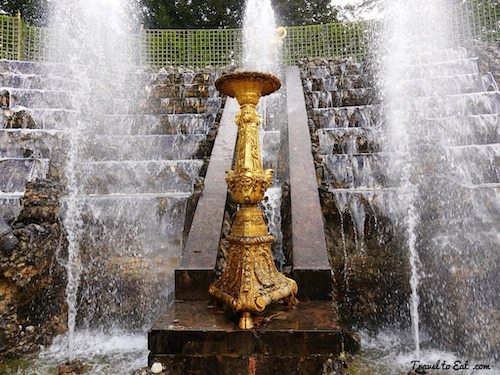
We returned to Versailles to see the afternoon fountain display. they have scheduled it between 3:30 and 5 PM this summer. That is not a lot of time to see much of the gardens, but I thought I would present the pictures I got. The Ballroom (Bosquet Salle de Bal or Bosquet des Rocailles) was created by Le Nôtre between 1680 and 1683. The grove was the last made before the installation of Louis XIV at Versailles. The Salle de Bal was inaugurated in 1685 with a ball hosted by the Grand Dauphin. The Ballroom is also called Seed Grove because the stones and shells came from the Madagascar coast over which water flows in the cascade. The musicians stood above the waterfall, across a tiered amphitheater with grass covered steps allowing spectators to sit.





As you enter the Ballroom, you see the grass stair seating with the waterfall at one end. Apparently the guests would sit on the grass seating in the amphitheater and there would be entertainment.


I have a star filter on my camera, so I took these two pictures. What do you think?




Next we went to the Grove d'Apollon-Bains (Bosquet des Bains-d'Apollon). Located immediately west of the castle, it was created by Hubert Robert in the romantic spirit in the reign of Louis XVI, between 1778 and 1781. The pre-romantic composition featured the conflict between art and nature. The statues themselves had been created much earlier, in 1666 and placed in the lower section of a water tower called the Grotte de Thétys. The water tower was destroyed in 1684, following the start of construction of the north wing of the castle of Versailles. The sculptures were then dispersed, moved several times, eventually ending up where they are today. The central group, done mostly by François Girardon is considered one of his finest works and the one that got him personally introduced to the king by Le Brun, with a purse of 300 louis, as a distinguishing mark of royal favor. In 1699 he completed the bronze equestrian statue of Louis XIV, erected by the town of Paris on the Place Louis le Grand. This statue was melted down during the French Revolution, and is known to us only by a small bronze model in the Louvre finished by Girardon himself. (see my post).

Started in 1664 and finished in 1670 with the installation of the statuary by the Gilles Guérin, François Girardon, Thomas Regnaudin, Gaspard Marsy, and Balthazar Marsy, the Grotte de Thétys formed an important symbolic and technical component to the gardens. Symbolically, the Grotte de Thétys related to the myth of Apollo – and by that association to Louis XIV. It was as the cave of the sea nymph, Thetis, where Apollo rested after driving his chariot to light the sky. The grotto was a freestanding structure located just north of the château. The interior, which was decorated with shell-work to represent a sea cave, contained the statue group by the Marsy brothers depicting the sun god attended by nereids (central grouping) and his horses being groomed by attendants of Thetis (the two accompanying statue groups). Originally, these statues were set in three individual niches in the grotto and were surrounded by various fountains and water features. Technically, the Grotte de Thétys played a critical role in the hydraulic system that supplied water to the garden. The roof of the grotto supported a reservoir that stored water pumped from the Clagny pond and which fed the fountains lower in the garden via gravity.



The Bacchus Fountain also called the Autumn Fountain is the same size as the three other fountains dedicated to the seasons and near the Royal Walk. Bacchus, a figure of Roman mythology, teaches the cultivation of the vine throughout the world. The god of wine and drunkenness, he symbolizes the harvest and is surrounded by small satyrs, half child and half goat. The Marsy brothers, Balthazar (c. 1624-1681) and Gaspard (1628-1674) were sculptors employed by King Louis XIV. They created the Fountain of Bacchus for the King's gardens at Versailles, along with the Fountain of Latone, mother of Apollo and Artemis, and the Fountain of Enceladus, the grand trumpeter. If Bacchus was a god of excess, Louis XIV was his fervent acolyte. Fully a third of the cost of the renovations to Versailles was spent on the waterworks to supply its 50 fountains. Thanks to Louis XIV, water is a problem at Versailles to this day.


It was a little windy the day we visited so the upper fountains at the Château were being blown around. Still, it was pretty cool to see the fountains in action, particularly since they were blasting classical music all through the gardens.
The fountains are activated at weekends and on public holidays from 11:00 am to 12:00 pm and from 3:30 to 5:00 pm (Neptune Fountain from 5:20 to 5:30 pm). Also on Tuesdays and on 29 March from 11:00 am to 12:00 pm and from 2:30 to 4:00 pm. It costs 8€ just for the gardens or 25€ for a pass for everything (Château, garden and Trianons)
References:
Les Bosquets: http://www.chateauversailles.fr/decouvrir-domaine/jardins/la-nature-disciplinee/les-bosquets
Les Bosquts en Plein Air: http://www.chateauversailles.fr/decouvrir-domaine/jardins/la-nature-disciplinee/les-bosquets/les-bosquets/salons-de-plein-air-1

